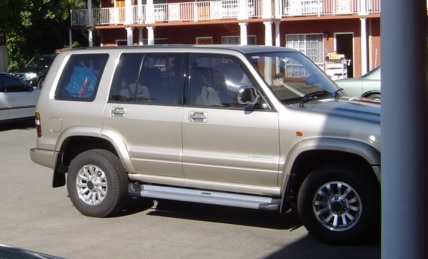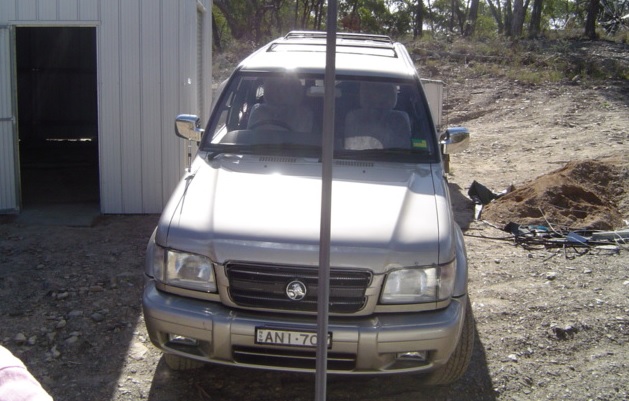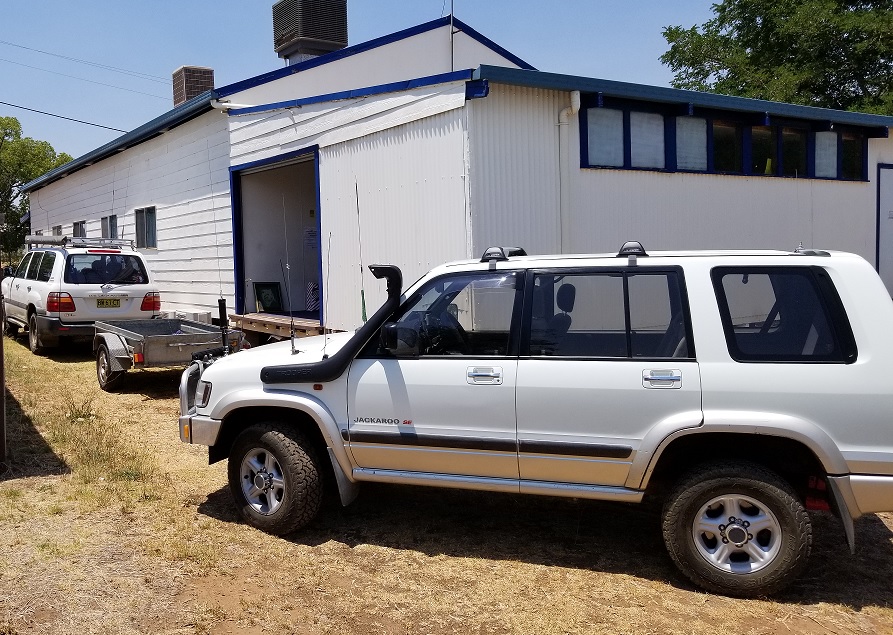






Holden Jackaroo Nullabor, build date Aug 2002 (made in Japan) 3.5L V6, 4speed Auto




Holden Jackaroo SE, build date May 2002 (made in Japan) 3.5L V6, 4speed Auto
This is the 3rd Jackaroo I have owned, I originally had 1998 SE auto 3.5L V6 petrol LWB(5-door), then a 2002 Nullabor auto 3.5L petrol LWB, both lease vehicles. In recent times I missed having a 4WD to go out bush and dirt roads in search of mountain top DXing with ham radio. I looked for a 2nd hand vehicle, not for daily driving, but just for weekend use only, I didnt want to buy a new Toyota Prado and get it all scratched driving down bush tracks, so opted for a 2nd hand vehicle, the Toyota Prados 2nd hand had huge mileage and and a huge 2nd hand price, I also looked at 4wd utes, such as Toyota Hilux, Holden Rodeo, Mazda BT50, but since they are in high demand, they also fetch over rated prices for something with high kilometres, so since I had owned Jackaroos in the past and since they had both been very reliable and since I also knew they were relatively RFI quiet, I went for the devil I knew, as I had learnt a lot about the Jackaroo from my brother inlaw who worked for Holden, I knew all the electronics, all the modules, like ECM, BCM, I could fix them no trouble if they failed in the future, whereas a newer vehicle takes the risk of having electronics that I can't fix. The Jackaroo was similiar size to Toyota Prado and Mitsubishi Pajero from that period, like all three, they built in Japan, tough, solid and reliable. I spent more than a year just looking around at 2nd hand vehicles, including Jackaroos, decided to go for the 3.5L V6 petrol, as too many concerns about oil seals in the diesel motor, prices were low for the Jackaroo, when compare condition and kilometres against Toyota Prado. Similiar aged Pajero's were scarse, so could not go wrong with the cheaper Jackaroo. I looked at the larger Toyota Landcruiser and Nissan Patrol, they are next size up from Prado,Pajero and Jackaroo, and obviously the 2nd hand price increases as those two vehicles are in demand as well. The Jackaroo that I bought had very little rust for a vehicle that was 14 years old (in 2016) (this current Jackaroo is a May 2002 build,) 3.5L V6, auto SE LWB with only 163,000km, for its age, it relatively low kilometres, so I knew what had to be replaced, what to expect. The downside of the V6 petrol is it chews fuel disgustingly when driven in the city, around 22L/100km carefully, or 25L/100km (or greater) if driven fast, even if using 98octane will only reduce consumption a small amount, on the open highway doing 110km/h it runs much better at 13L/100km using 98 octane, hence you only want one of these for highway driving out in the country. And the 3.5L V6 petrol do not like 91octane or E10, the engine pings, (that is because in australia we export our high grade crude oil and import crap crude oil from Middle East, so that the measured octane is less than what the petrol pump says) I had the same pinging on the previous two Jackaroos, stick to 95octane around the city and use 98octane for highway use, as you dont get any benefit using 98 octane with city driving, in terms of this vehicle. Modifications: 1. to improve RFI created by engine ignition and fuel injectors, I added clip-on ferrite cores at the injectors and at the ignition coil blocks. These engines are multipoint fuel injection and not common-rail (direct) injection as seen on new cars, which create much greater RFI that interferes with HF and VHF radios. (that's why modern cars put the shark fin antennas at the rear of the car, to minimise interference from the engine to radio reception in the AM/FM radio in the car) The clip-on ferrite cores can be purchased in different internal diameter, to suit different cable thickness ( i.e. 3.5mm, 5mm, 7mm, 9mm, 11mm and 14mm) You can find clip-on ferrite cores on Ebay. I used 7mm cores on Injector cables, 9mm cores on the ignition blocks (the low voltage DC side of the block) I also added ferrite cores to the ground points, this is where the DC return wire (Zero volt) come together to be grounded on the chassis, these are located on the engine itself and chassis points in engine bay. I also added larger diameter ferrite cores (14mm) on major harness feeds, i.e where it passes through the firewall. I also added ferrite cores on the harness at each of the electronics modules, i.e ECM, BCM located below centre console, as well as the Alarm/Immobiliser module. The Alarm/Immobiliser module radiates a strong birdie at approx 146.925 MHz and it wanders with temperature variation, it is annoying when scanning 2metre repeaters. Engine ignition noise found to be worse on the higher HF bands though to 6metre band, I found the same on Holden Commodore V6 engines too. 2. Adding ferrite cores to the harness at rear of AM/FM stereo radio, this is becaause the radio itself radiates birdies on VHF, plus reduces stray RF from VHF transmitters getting into the stereo too, ie. clicks and thumps propagated to the stereo speakers. 3. running coax cable to the bullbar, run it through the inside the upper front guards, rather than through the firewall and engine to reach the front bullbar.You dont want stray radiated RFI from inside engine bay travelling along your coax. 4. I needed somewhere to run the Codan HF from, so I mounted it on the rear door, that is the small door, I added waterproof foam layer on rear of plastic door panel, to reduce audio noise, from driving on dirt roads. 5. I removed the ashtry so I can mount a quad band radio remote head 6. I removed the dummy 2nd DIN panel, so I could mount another VHF/UHF radio remote head underneath the AM/FM stereo radio. 7. Eurovox AM/FM/CD stereo died, so replaced it with a modern FM/Bluetooth/MP3 stereo unit, desoldered the multi-pin connector from rear of the Eurovox to make up a new interface harness between the Eurovox stype connector attached to the internal harness and interface it to the new JSD-520 stereo.(refer to the photos). 8. I ran 8GA OFC twin lead cable from battery to under the seats to run the radios with, whilst minimising voltage drop. 9. I ran 8GA OFC twin lead cable to rear cargo to provide low voltage drop for when running radios from cargo area, i.e. when portable, because even though there is a cigarette lighter socket at the rear, the wiring is so thin it creates big voltage drop, even at a couple Amps. 10. added USB power sockets front & rear. Ensuring these are heavily filtered due to RFI radiating from USB 5.1v switcher circuits. 11. replaced the foam strip around the edge of the engine radiator, with a rubber door-trim type tubing, to seal the gap, as cooling air passing around the radiator instead of going through the radiator (taking path of least resistance) so now engine cooling working better. 12. replaced the 18inch viscous clutch fan with two 12inch electric puller fans mounted on the radiator core, along with thermo switched relay. Now the engine is much more responsive instead of trying to rotate the heavy viscous clutch fan. this should really reduce fuel consumption. 13. added 10inch electric pusher fan to the air-con condensor radiator core to assist air-con cooling in slow traffic conditions. Just need to add condensor relay in engine bay fuse box, and hook the wire at the H41 harness connector to drive relay off the magnetic clutch driver relay, which runs through harness H42. This is because the 2nd condensor pressure switch is not present. 14. Added thin, white, foam packaging sheets, collected from various shipments, I used it throughout for noise suppression, anywhere there is plastic and metal rattling. It is now much quieter travelling along dirt roads. Vehicle Specifications: Engine is a 6VE1W 3.5L DOHC 24V V6 which was introduced in 1998 with 215 hp (160 kW) and used until 2004. The Isuzu V engine is a family of all-aluminum 75� V6 gasoline engines produced by Isuzu. The 6VE1W is a belt-driven DOHC valvetrain. It has multi-port fuel (petrol) injection. Wet sump oil lubrication and water cooled. It is based on the General Motors LG6 motor It has a 4-speed General Motors 4L30-E automatic transmission. Dimensions: Wheelbase 5-door: 104.3 in (2,649 mm) Length 5-door: 176.0 in (4,470 mm) Width 65.0 in (1,651 mm) Height 5-door: 71.7 in (1,821 mm) ODB2 Diagnostic interface is Mode 7 Known Issues: 1. the metal lip at top of windscreen collects water and the rubber strip and causes rust holes, you must remove the rubber seal and check for rust, repair it and seal it. All three vehicles I had get water in passenger front floor coming down back of dashboard. Poor design. refit the rubber seal with a waterproof base glue as a seal. 2. petrol filler cap, the suction cap within the larger cap, gets sticky and causes vapor lock, when drive all day on a long trip, the vapor lock makes the engine faulter and cough under load. Just clean the spring loaded seal with throttle body cleaner or similar. 3. EGR valve gets clogged with carbon buildup, causes surging when coasting downhill (no throttle). Just blank it, as it creating more problems than good. 4. overheating automatic transmission, climbing mountain roads, on hot days, at slow speeds, it dont like it, the temperature rises quickly, when it gets too hot, it becomes very sluggish, almost stalling the engine, and it refusing to move a metre, you need to stop, put it in Park position and wait until it cools down a bit, keep engine running to circulate the transmission fluid via the radiator. 5. I have heard the door window frame support becomes brittle and breaks, probably need to manufacture your own replacement part using a 3D printer. 6. under heavy rain, water can get into the air box, via air vent between bonnet and windscreen. Water runs down firewall behind console. 7. water leak, rear door, top left corner, it sneaks in via the rubber door seal, wets the cargo area carpet under heavy rain, in rear left corner. Improved Performance and Fuel Economy: I have improved the fuel economy, most noticeably on highway cycle. On some trips from Sydney to Tumut, I have got average of 10.4 and 10.8 L/100km, using 98 octane and sitting on 110km/hr on the Hume Highway, compared to it sucking 22L/100km or greater driving around the city. I found optimum speed on highway for best economy would be 90-100km/hr where it runs at 10L/100km, and going above 110km/hr sees a rise in fuel flow. I attribute the improved fuel economy on the highway to four things. 1. higher octane 95 or 98, better than crap 91 octane, I dont get pinging using 95 or 98 octane. 2. blanking EGR. performance is noticebly better and smoother idle. 3. replacement of viscous radiator fan with electric fans, you dont need to be pulling air through radiator at speed. 4. Ram fed snorkel, getting cooler air and higher volume at speed, you can see that from the MAF air volume sensor readings and Intake temperature reading. Having the OBDII data collection is great.







Holden Jackaroo Nullabor, build date Aug 2002 (made in Japan) 3.5L V6, 4speed Auto




Holden Jackaroo SE, build date May 2002 (made in Japan) 3.5L V6, 4speed Auto